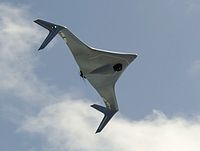
Photo from wikipedia
In recent times, technological advancement boosts the desire of utilizing the autonomous Unmanned Aerial Vehicle (UAV) in both civil and military sectors. Among various UAVs, the ability of rotary wing… Click to show full abstract
In recent times, technological advancement boosts the desire of utilizing the autonomous Unmanned Aerial Vehicle (UAV) in both civil and military sectors. Among various UAVs, the ability of rotary wing UAVs (RUAVs) in vertical take-off and landing, to hover and perform quick maneuvering attract researchers to develop models fully autonomous control framework. The majority of first principle techniques in modeling and controlling RUAV face challenges in incorporating and handling various uncertainties. Recently various fuzzy and neuro-fuzzy based intelligent systems are utilized to enhance the RUAV’s modeling and control performance. However, the majority of these fuzzy systems are based on batch learning methods, have static structure, and cannot adapt to rapidly changing environments. The implication of Evolving Intelligent System based model-free data-driven techniques can be a smart option since they can adapt their structure and parameters to cope with sudden changes in the behavior of RUAVs real-time flight. They work in a single pass learning fashion which is suitable for online real-time deployment. In this paper, state of the art of various fuzzy systems from the basic fuzzy system to evolving fuzzy system, their application in a RUAV namely quadcopter with existing limitations, and possible opportunities are analyzed. Besides, a variety of first principle techniques to control the quadcopter, their impediments, and conceivable solution with recently employed evolving fuzzy controllers are reviewed.
Journal Title: Artificial Intelligence Review
Year Published: 2018
Link to full text (if available)
Share on Social Media: Sign Up to like & get
recommendations!